What Goes into Building and Maintaining a Hiking Trail?
I have been building and maintaining trails since the early 1990’s in the Coast Mountains with the B.C. Mountaineering Club. Many of the trail building skills and techniques I have learned and developed over the years have been passed down from member to member in the field. In this article, I wanted to share with you some of what is involved in creating and maintaining a trail in the Coast Mountains.
Firstly, you cannot simply park your truck at the end of a logging road and start building a new trail. For any new trail, I first begin by carefully studying numerous topographic maps, and inspect satellite imagery closely to pre-plan the route. A reconnaissance trip to flag the planned route usually follows next. Once the proposed route for the new trail has been chosen, I must consult with Government officials and obtain permission for any trail to be constructed on crown land. This is known as obtaining a “Section 57” from the Ministry of Forest Lands and Natural Resource Operations. There are in fact very few official Section 57 backcountry hiking trails in the Sea to Sky Region (around 5 in fact). Obtaining a section 57 can be difficult. A written application is required with extensive mapping. After the application is submitted, consultation must happen with all parties who have an interest or stake in the area in which the trail will travel through (including and especially all First Nations).
In the case of the Watersprite Trail, due to soft ground, heavy rainfall, dynamic creeks, swamps and micro-terrain, I made sure that the trail would utilize old logging roads as much as possible. Micro-terrain refers to the subtle and complex features on the landscape that are too small to appear on topographic maps and on satellite imagery. Contending with Micro-terrain as a trail builder and planner requires great experience, intuition and knowledge and is a rare skill set.
Building the Trail
We first begin by clearing the logging roads and marking the planned route. The greatest menace is the mighty red alder, which rapidly grows in all directions like an octopus and can obliterate and choke any old logging in a few short years. A team of chainsaw and brush cutter operators (with a spinning steel disc saw at the end) takes the lead, while a team of “swampers” in the rear throws the fallen debris to the side of the trail. We also employ a wide variety of hand tools such as loppers, handsaws, axes, pry bars, etc. If the road is old and badly overgrown, this effort can be brutal work. As an example, on one badly overgrown road in the Skookum Valley, our team of 5 chainsaws operators, two brush cutters and supporting swampers were only able to clear a pitiful 300 meters of road per day.
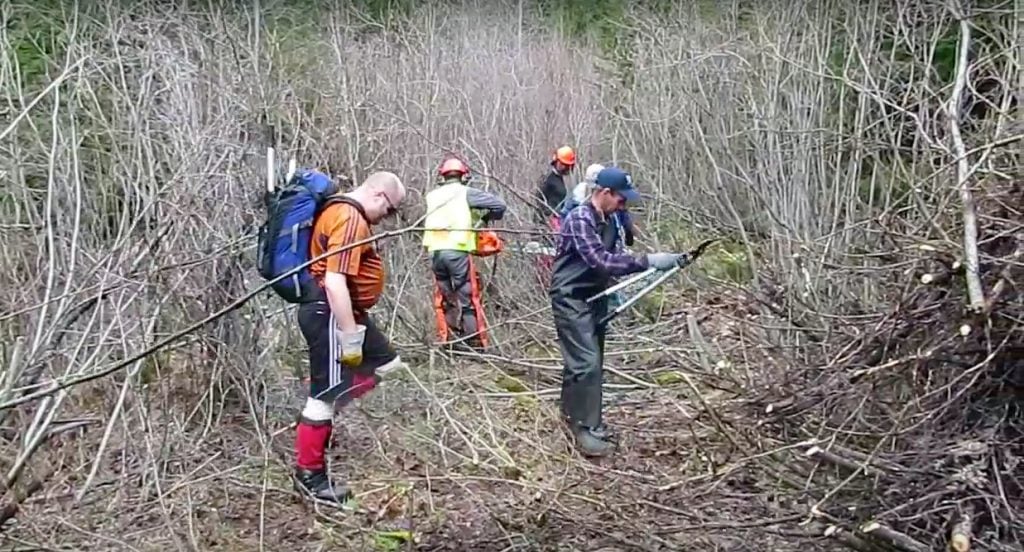
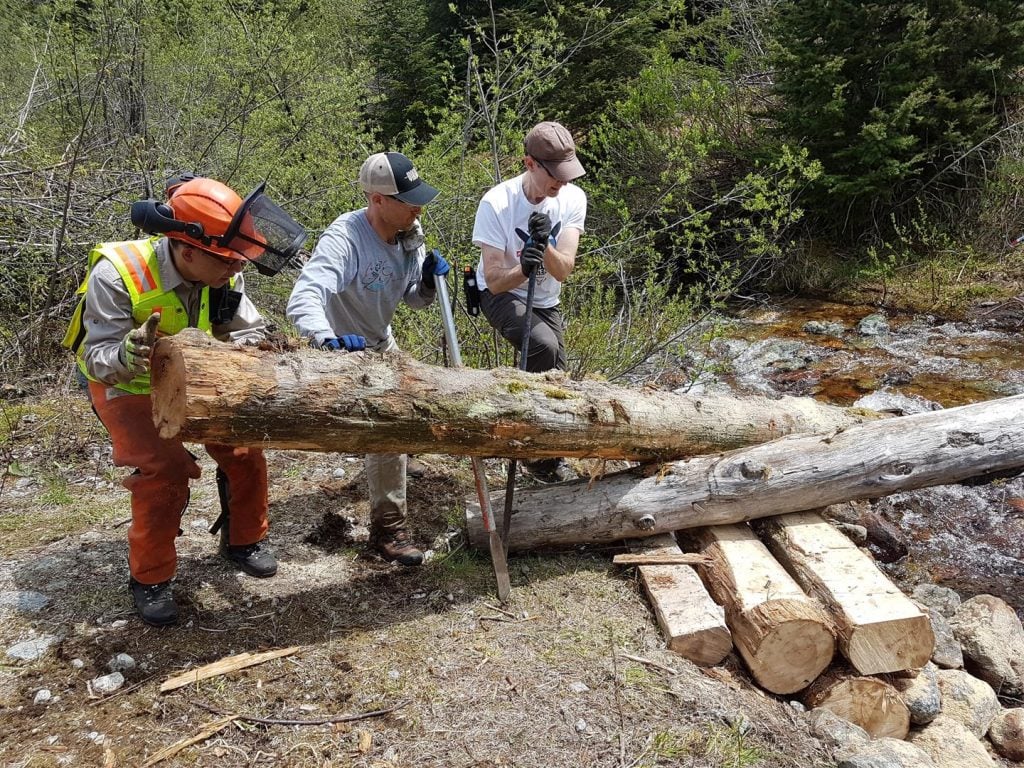
Once the trail has been “punched through” and the route established, which can take a dozen day trips or more, the next step is to enhance and upgrade the trail.
Upgrading the trail for the masses
As the number of hikers has exploded in recent years, and the number of destinations has decreased due to a decline in access resulting from forest road loss and deterioration, the use impacts on any new trail that the public has become aware of is enormous. Heavy foot traffic will rapidly turn a small mud puddle into a sea of muck in a single year. A steeper section of trail where the ground is not stabilized will rapidly lose all its top soil and will become a mucky and slimy root-ladder is short order (there are many fine examples of this out there). To mitigate these problems, we drain the water by digging cross ditches. Where this is insufficient, boardwalk may be required. Boardwalk however is laboursome and expensive as we have to purchase and carry in all of the materials. Steep sections of trail are stabilized with stairs created using lumber that is supported by vertically pounded rebar which are then backfilled using shovels.
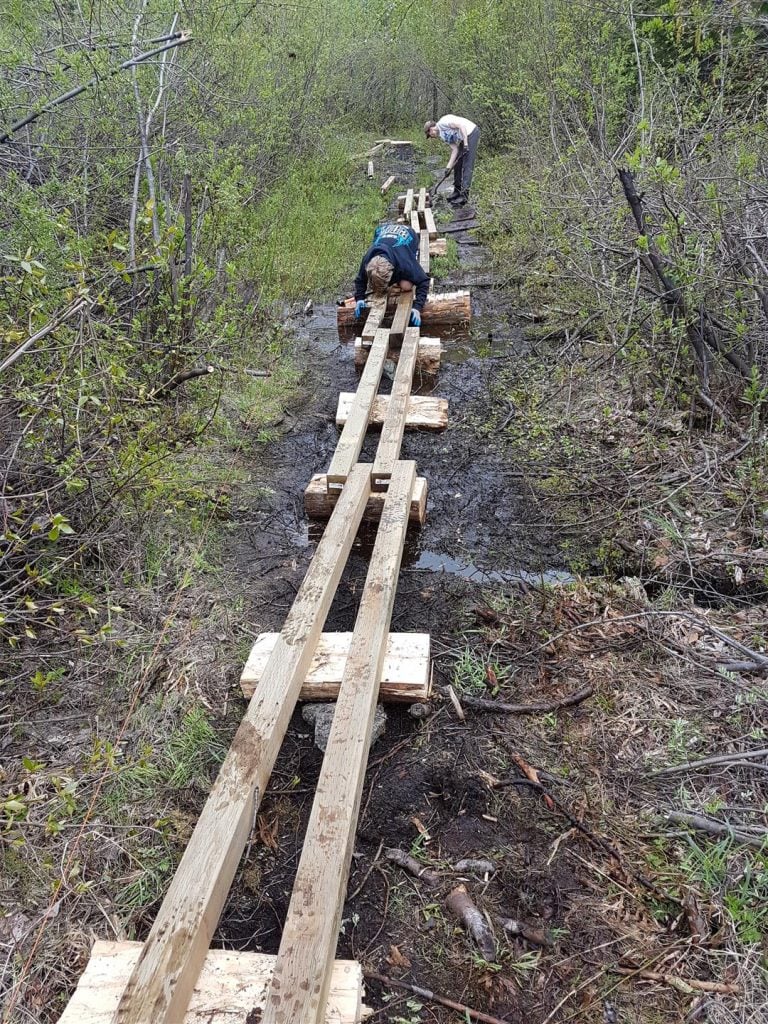
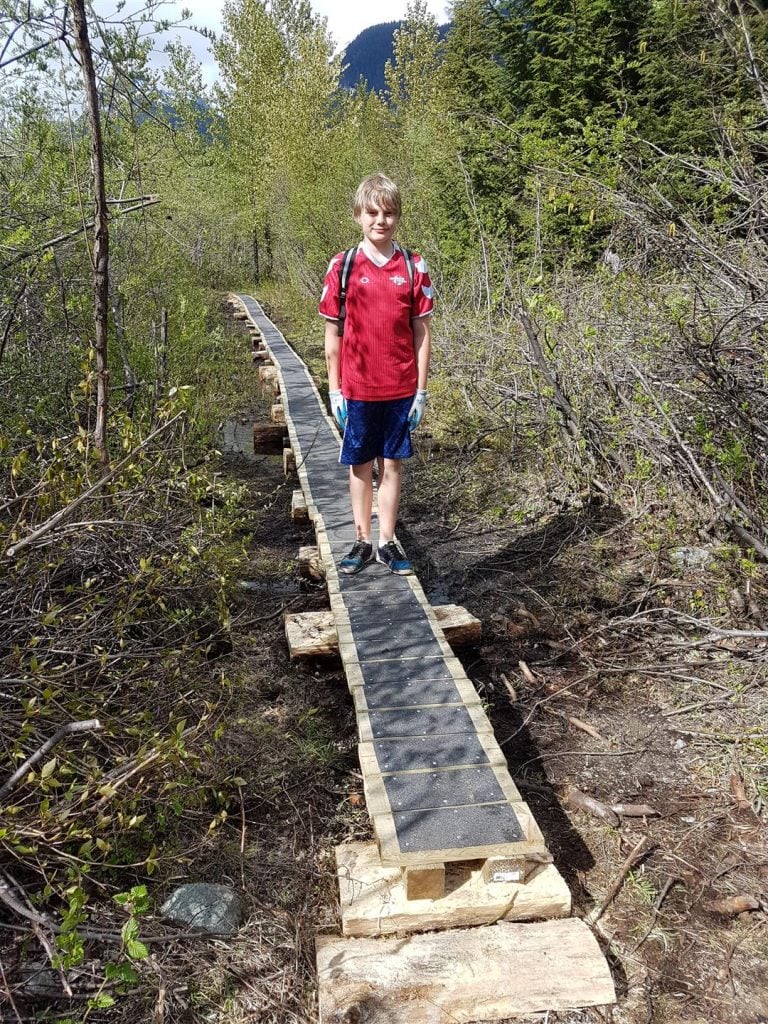
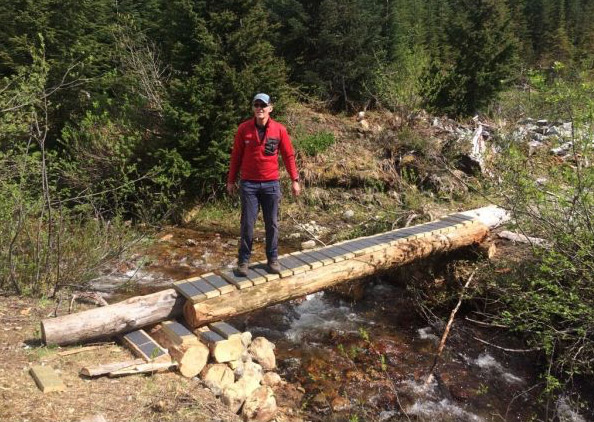
Bridges must be built across the larger creeks, but these also present challenges. Firstly, we cannot fall trees for materials as this is illegal and requires a timber license. For bridges, we must find naturally fallen material and haul them into place over the creek. To make things more challenging, different woods rot at different rates, therefore we choose only naturally fallen red and yellow cedar whenever possible. This requires the use of Come Along Cable Puller systems, chainsaws, pry bars and a lot of physical might. We also have to construct gabions (piles of rocks or stacked logs) on each bank to support the logs/beams, and hammer the logs into the ground and the gabions using sledge hammers and long sections of rebar (with pre-drilled holes using a hand drill). This is of course a large operation. Decking is then added to the bridges, along with non-slip asphalt roofing pre-cut into strips to prevent nasty falls on wet days.
Yearly Maintenance
Every year the snow bends over a large amount of alder and falls timber on the trail (known as deadfall). New mucky sections appear and damage from heavy traffic needs to be addressed. Before the leaves appear on the alder and as the snow first retreats, we typically do a clearing run with the brush cutters and hand loppers. Sometimes, we even have to deal with landslides, slope failures, or damaged trail infrastructure. We typically perform this work in both the spring and the fall. As in the construction of the trail, yearly maintenance is a multi-day effort.
Final thoughts from a Trail Crew Chief
I often encounter complaints on social media about the condition of a trail that I am responsible for (such as the new Watersprite Like Trail which is still under construction and undergoing major upgrades) and wanted to provide my perspective. I take personal pride in making sure the trails I am responsible for are in the best shape they can be in. That being said, I and the members of my crew are unpaid volunteers and the Coast Mountains are brutal and unforgiving in their treatment of any trail. As volunteer trail builders who have families, busy lives, and limited resources, we are doing the best we can, and I know that there is always more that could be done. We very often spend our own money to work on these trails sometimes a dozen or more times a year. We are deeply committed, and enjoy the work.
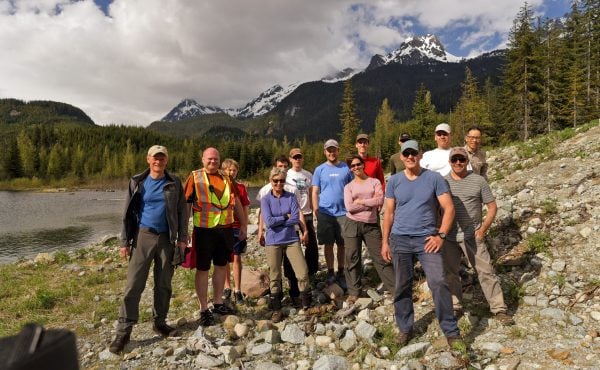
The explosion in the number of hikers and the promotion of hiking and the outdoor lifestyle, in addition to the power of social media to rapidly share the existence of a new trail (this combined with a serious shortage of quality hiking trails and destinations in the coast) has placed a serious burden on us trail builders. I also have concerns and worry about the safety and well being of the large number of unprepared hikers I see using our wilderness trails.
We need your help. You can do your part to help us by volunteering for a trail clearing trip, or donating to the BCMC trail building fund (known as the BCMC conservation fund).
Remember, that without us trail builders, there would be precious few hiking destinations. Imagine how unpleasant and crowded hiking to Garibaldi Lake or Joffre Lakes would be if those park trails were the only hiking destinations available to the public.
See you on the trail.
Chris Ludwig – BCMC Webmaster and Trail Building Crew Chief
Chris Ludwig has been and avid hiker, mountaineer and trail builder in the BC Coast Mountains for over 25 years. He currently serves as the Webmaster, Conservation Chair and Volunteer Trail Crew Chief for the B.C. Mountaineering Club. He is also the co-founder and Webmaster for the Garibaldi Park 2020 organization.
One response to “What Goes into Building and Maintaining a Hiking Trail?”
Leave a Reply
Comments that gratuitously attack or demean individuals or organizations are not acceptable. We reserve the right to remove comments or any other content we deem unacceptable in our sole discretion, including removing user names and profile pictures. For our full website terms and conditions including our legal guidelines for user postings and comments on www.vancouvertrails.com, please see our Terms of Use and Privacy Policy.
Thank you for the wonderful work you and your team are doing. You have provided me with wonderful memories of the backcountry, something I could not do without your dedication and hard work. I look forward to going to Watersprite Lake this summer.
Keep up the good work.
Diane